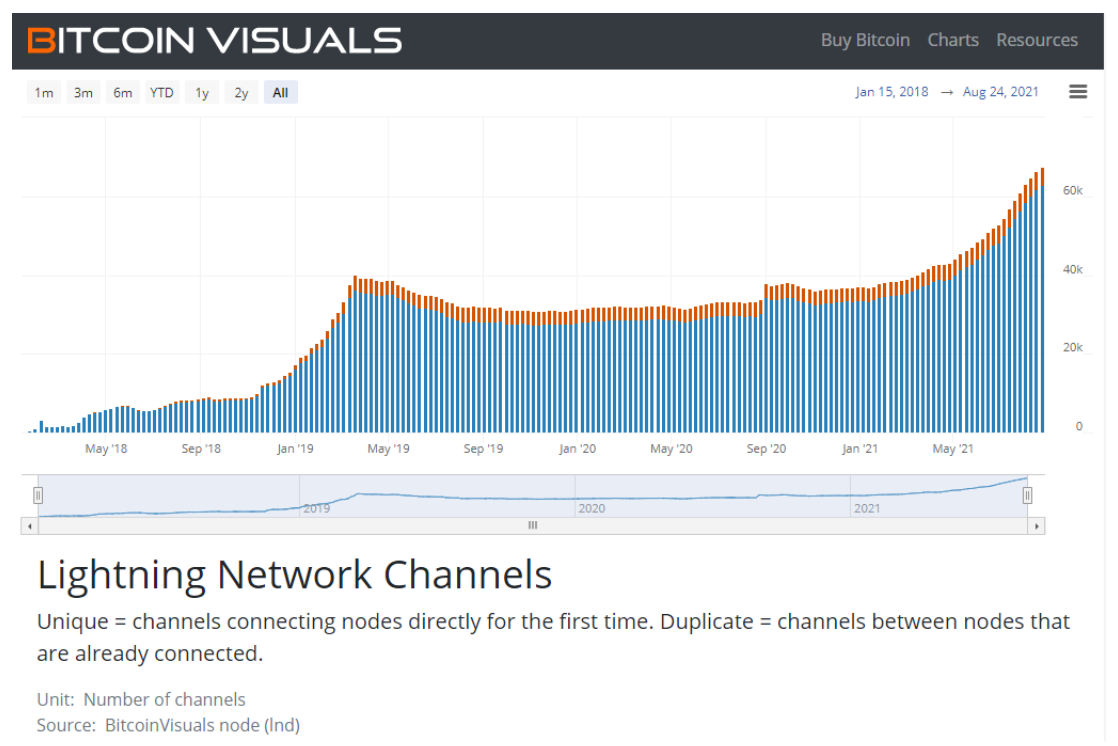To investors,
Below is a guest post overview of the Lightning Network from Mitch Klee. You can follow him on Twitter by clicking here.
Lightning network has been on track to change the game for Bitcoin. Drafted in 2015 and launched in 2018 by lightning labs, the lightning network has made leaps and bounds for Bitcoin in multiple areas, some of which are still yet to come. Using native smart contract scripts of Bitcoin, Lightning gives the ability for users to make near instant payments at less than a cent. This low-cost scalability solution brings micro-payments to the forefront of our everyday lives. Historically Bitcoin has had a transaction rate of about 7 transactions per second. Legacy solutions like Visa took 30 years to get to 40k transactions per second, Lightning has the ability to scale to 100k or more.
Growth of the Past Few Years
Lighting has grown at an incredible rate. Because of the growing ecosystem and open source nature of the technology, many developers are able to build and add value to the payment systems network, bringing new innovations on top of Bitcoin’s Base layer.
(https://bitcoinvisuals.com/ln-capacity)
After explosive growth in the bear market, we have seen a building period that culminates in a huge rise in the number of Bitcoin inside lightning channels. The orange line is the number of Bitcoins in channels and blue bars are the dollar amount. This means Bitcoin is being added to more and more channels, giving the network the ability to create more connections and liquidity.
(https://bitcoinvisuals.com/ln-channels)
A good way to understand a lighting channel is to compare it to a bar tab. You keep an open channel (tab) with someone (bartender), and every time you interact (buy a beer), those Bitcoins are sent through the channel. Once you finish the transactions, you close the channel (tab), and that interacts with the base layer of Bitcoin sending it to the on-chain wallet. The beauty of the lightning network, is that even if you don’t have a direct channel with someone, you can find a path through other nodes, making a number of hops to the final destination.
Scaling with the Lightning Network
Being that Lightning is an open source network, people can opt in and create new functionalities. Umbrel has been a huge contributor for a plug and play way of getting onto the lightning network, making it easy to setup your own node. Other apps like Muun and Strike have made transacting on the lightning network extremely easy, and its only getting better from here.
Bitcoin’s base layer benefits huge from Lightning and transaction fees are reduced largely because of how secure lighting is to use. Previous to 2018, transacting on Bitcoin’s base layer was extremely costly in times of congestion. With exchanges like Kraken implementing lightning payments, this will save the users, exchanges, and base layer a huge amount of congestion causing a cascade into lightning as other exchanges get more competitive.
Peer to Peer Network and the Creator Economy
It’s not only the plebs and exchanges that see benefits, but content creators as well. Substack just recently announced in partnership with Opennode, they are giving subscribers the ability to send Bitcoin over the lightning network to pay for subscriptions. This is huge for the content creator community. In the future, it may be possible to send micropayments to read single articles, rather than subscribing. Adam Curry’s Podcasting 2.0 has also made waves in the lightning and podcasting community promoting podcasting to what his original vision was, “Value 4 Value”. An app called Sphinx Chat allows you to listen to podcasts, stream sats every minute and even send tips. There has even been talks about Jack from Twitter implanting lightning payments in the app itself. Imagine joining a Twitter Space and being able to tip the speakers sats for useful information, real time.
Cross Border Payment Technology
One of the biggest innovations using Lightning is in the form of cross border payments. In 2019, Jack Mallers announced a new platform called Strike, which used lightning and Bitcoin infrastructure to implement cross border payments. It converts dollars in real time from your account, sends them over the lightning network instantly and converts back to dollars. So, say you were an immigrant working in the United States wanting to send money back to your family, usually you would have to pay anywhere from 10 – 50% in fees through western union and conversion, just to get that money back home. With strike and the lightning network, you can send that money back for less than a penny.
Lightning and the Future of Bitcoin
As the Bitcoin Lightning Network grows in adoption, Bitcoin is beginning to transform into a high transaction rate currency without borders. Before, Bitcoin’s base layer was the first and most decentralized immutable ledger, but it was slow. Layer 2 is starting to transition us into the world that we all knew was possible. It is faster, more decentralized and boundless. Layer 2 allows Bitcoin to act more like a currency with high transaction throughput. Couple this with the ability to add stacks of code and build technology layers like the internet, and it becomes an unstoppable force.
That is it for today’s analysis. Hopefully you found this helpful. I highly suggest you follow Mitch Klee on Twitter. You can follow him on Twitter by clicking here.
-Pomp
SPONSORED: Amber Group is a leading global crypto finance service provider operating around the world and around the clock with a presence in Hong Kong, Taipei, Seoul, and Vancouver. Founded in 2017, Amber Group is committed to combining best-in-class technology with sophisticated quantitative research to offer clients a streamlined crypto finance experience.
The platform now services over 500 institutions and 100,000+ individual investors across the Amber Pro web platform, the Amber App, as well as their 24/7 trading desk. To date, Amber Group has cumulatively traded more than $330 billion across 100+ electronic exchanges, exceeding $1 billion in assets under management. In 2019, Amber Group raised $28 million in Series A funding led by global crypto heavyweights Paradigm and Pantera Capital, with participation from Polychain Capital, Dragonfly Capital, Blockchain.com.
Click here to sign up now.
LISTEN TO THIS EPISODE OF THE POMP PODCAST HERE
Nic Carter is a Partner at Castle Island Ventures and a Co-Founder of CoinMetrics.
In this conversation, we discuss bitcoin, mining, Ethereum, smart contract platforms, Castle Island Ventures, Coinmetrics, geo-political issues, and then we roll the FUD dice.
LISTEN TO THIS EPISODE OF THE POMP PODCAST HERE
Podcast Sponsors
These companies make the podcast possible, so go check them out and thank them for their support!
Polymarket - Polymarket is the world’s leading information markets platform where you can trade on the most pressing global questions and see unbiased, real-time data on what the market thinks will happen – all on the blockchain. Will the US have more than 100,00 covid cases before 2022? For a limited time, sign up with referral code “Pomp” to get your first trade reimbursed up to $100. Click here to get started!
BlockFi provides financial products for crypto investors. Products include high-yield interest accounts, USD loans, and no fee trading. To start earning today visit: http://www.blockfi.com/Pomp
Cosmos is building the Internet of Blockchains, marking a new era of interoperability, scalability, and usability. The free flow of assets and data between blockchains with bridges to Ethereum and Bitcoin will unleash the potential of DeFi, NFTs, and much more. Dive into Cosmos at cosmos.network/pomp
Choice is a new self-directed IRA product that allows you to buy Bitcoin with tax-advantaged dollars, while still holding your private keys. You can go to retirewithchoice.com/pomp to sign up today.
LMAX Digital - the market-leading solution for institutional crypto trading & custodial services - offers clients a regulated, transparent and secure trading environment, together with the deepest pool of crypto liquidity. LMAX Digital is also a primary price discovery venue, streaming real-time market data to the industry’s leading analytics platforms. LMAX Digital - secure, liquid, trusted. Learn more at LMAXdigital.com/pomp
Crypto.com allows you to buy, sell, store, earn, loan, and invest various cryptocurrencies in an user friendly mobile app. Join over one million users today. You can download and earn $50 USD with my code “pomp2020” when you sign up for one of their metal cards today.
Circle is a global financial technology firm that enables businesses of all sizes to harness the power of stablecoins and public blockchains for payments, commerce and financial applications worldwide. Circle is also a principal developer of USD Coin (USDC), the fastest growing, fully reserved and regulated dollar stablecoin in the world. The free Circle Account and suite of platform API services bridge the gap between traditional payments and crypto for trading, DeFi, and NFT marketplaces. Create seamless, user-friendly, mainstream customer experiences with crypto-native infrastructure under the hood with Circle. Learn more at circle.com.
Gemini is a leading regulated cryptocurrency exchange, wallet, and custodian that makes it simple and secure to buy bitcoin, ether, and over 30 other cryptocurrencies. Offering industry-leading security, insurance and uptime, Gemini is the go-to trusted platform for beginner and sophisticated investors alike. Open a free account in under 3 minutes at gemini.com/pomp and get $20 of bitcoin after you trade $100 or more within 30 days.
Amber - Invest, trade, swap, and earn crypto with Amber App, where new users can receive 16% APR on BTC, ETH, and USD Stablecoins! Click here to sign up now.
Bubble - Do you have a business idea you’ve been dreaming about, but don’t know how to actually start building it? Use Bubble’s drag-and-drop tool to develop custom, interactive, multi-user web apps in hours. Go to Bubble.io/pomp and the first 500 readers will get their first month free on any of Bubble’s paid plans.
Mask Network - The portal to the new, open internet. Building on top of the existing social networks, the Mask extension allows borderless cryptocurrency transfer, decentralized file storage and sharing, decentralized finance, and many other features that were once impossible to interact with on traditional social media. Visit mask.io/pomp and use the extension to start exploring the decentralized application world.
Okcoin - Okcoin is one of the most popular licensed exchanges. Okcoin is the first to bring new cryptos to market, offering some of the lowest fees in the industry, an easy to use app, and Earn feature! It’s easier than ever to sign up, buy and trade crypto in just 2 minutes on Okcoin with credit & debit cards or just link your bank account to the best new crypto assets. So get started, and go to okcoin.com/pomp
Matrixport - Matrixport is Asia’s fastest growing digital asset platform with $10 billion in assets under management and custody. It offers one-stop crypto financial solutions including fixed income, DeFi in 1-click, structured products, Cactus Custody™, spot OTC and lending. Go download the Matrixport App and enjoy a welcome offer of 30% APY on USDC for new users.
Masterworks - Masterworks.io is the leading platform for blue-chip art investing with over 185,000 registered users. They have purchased over $180MM in art from artists like Banksy, Basquiat and KAWS.
You are receiving The Pomp Letter because you either signed up or you attended one of the events that I spoke at. Feel free to unsubscribe if you aren’t finding this valuable.
Nothing in this email is intended to serve as financial advice. Do your own research.
You’re on the free list for The Pomp Letter. For the full experience, become a paying subscriber.







